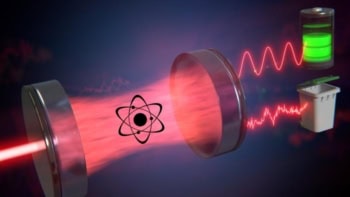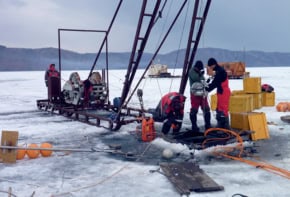The Belle collaboration at the KEK laboratory in Japan has reported the most accurate measurement to date of the angle ø3 in the "unitarity triangle" that describes the difference between matter and anti-matter in the Standard Model. The team used a technique known as Dalitz plot analysis to analyze the decays of charged B-mesons and their antiparticle equivalents (K Abe et al. 2005 arXiv.org/abs/hep-ex/0504013). By measuring all the angles in the unitarity triangle, and also the lengths of the sides, physicists hope to understand more about the violation of charge-parity (CP) symmetry in nature and why the universe does not contain equal amounts of matter and anti-matter.
CP violation is responsible for the difference between matter and antimatter in the Standard Model. CP violation means that the laws of physics change slightly when a particle is replaced by its antiparticle and all three directions in space are reversed. CP violation was first detected in kaons in 1964. However, it was not observed in another system until Belle and a similar experiment at Stanford called BaBar observed it in B-meson decays in 2001.
The amount of CP violation in the Standard Model is proportional to the area of the unitarity triangle. The base of this triangle is one unit long, so physicists need to measure the values of two more angles or lengths to calculate the area. However, the more angles and lengths they can measure, the better they can test and explore the model.
A B-meson contains a bottom quark and either an anti-up or anti-down quark, and it can decay into a variety of other particles, as can an anti-B-meson. By counting the numbers of particular combinations of particles produced in these decays, it is possible to determine the sizes of the various angles and the lengths of the different sides in the triangle.
The Belle scientists measured rare events in which a charged B-meson decayed into a neutral D-meson and a charged kaon. The neutral D-meson then decayed into a “three-body” state consisting of a positive pion, a negative pion and a neutral kaon. From the slight differences in the decays of the B-mesons and the anti-B-mesons, they extracted a value of 68°, plus or minus 15°, for the angle known as ø3 (which is also known as gamma) The angle ø1 (beta) has already been measured by both BaBar and Belle with a precision of several degrees, but the precise value of ø2 (alpha) has not been obtained yet.
Previously it was thought that it would not be possible to measure ø3 because of the statistically small number of events produced in experiments like Belle. However, the Dalitz analysis technique is several times more sensitive than other methods, which allows ø3 to be constrained with reasonable precision. Although the new result implies that CP violation has been seen in the experiment, Anton Poluektov of the Belle collaboration says the team is reluctant to state that it has directly observed CP violation because of the low number of events.
“This particular result is just a first try of the promising method of ø3 measurement,” he says. “Although currently our result will not have any theoretical impact, in the future, when more data will be available, a precise measurement of ø3 — as well as the other angles and sides of the unitarity triangle — would allow to check the consistency of the Standard Model, and to search for effects which can be explained by the extensions of the model, like supersymmetry and grand unified theories.”



